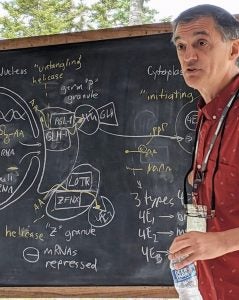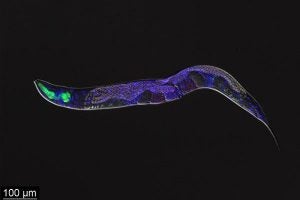ECU researcher learns new techniques to study mRNA
An East Carolina University faculty scientist delved into the intricacies of messenger RNA this summer to learn more about how it gets sorted, stored and translated into proteins during gamete and embryo development to discover the causes of infertility and birth defects.

ECU’s Brett Keiper, right, spent the summer studying Crispr/Cas9 methods and fluorescence microscopy of mRNA complexes in the lab of Dustin Updike at Mount Desert Island Biological Laboratories in Bar Harbor, Maine. (Photo by Kevin Bennet, MDIBL)
Brett Keiper, an associate professor and graduate director of biochemistry and molecular biology at the Brody School of Medicine at ECU, spent six weeks in July and August at Mount Desert Island Biological Laboratories in Bar Harbor, Maine. A three-year, $263,000 Mid-Career Advancement Award from the National Science Foundation is funding the work for himself and a doctoral student through 2024.
mRNA carries short bursts of genetic information from DNA in a cell nucleus to the main part of the cell — the cytoplasm — where proteins are made from its code. The cellular machinery then builds the proteins from the mRNA, as encoded by the DNA, that are right for that time and place in a cell to help it change to new types, as happens in an embryo. The translation factors also give the cell a way to control the rate of protein production — turning the mRNAs “on” or “off” as needed.
mRNA instructions are timed to self-destruct, like a disappearing text or Snapchat message. Once the instructions vanish, protein production stops until the protein factories receive a new message for a new fate.
At Mount Desert Island, Keiper worked with Dustin Updike, an associate professor and program coordinator of Maine INBRE (IDeA Network of Biomedical Research Excellence), a National Institutes of Health institutional development and student education and training program.
Specifically, Keiper learned to streamline the Crispr-Cas9 engineering process by adapting the Updike lab methodology. Crispr stands for clustered regularly interspaced short palindromic repeats. It can precisely target a designed edit in one gene out of the entire genome. Crispr is the premier gene-editing tool and is particularly versatile for animal model systems where such experiments are ethical and feasible.

Brett Keiper lectures on the lifetime of mRNA in germ cells at Mount Desert Island Biological Laboratories in Maine. (Photo courtesy Brett Keiper)
He also learned more elaborate fluorescence microscopy techniques, RNA bioinformatics and genotype screening processes. “Most importantly, however, I am accomplishing some of the joint collaborative experiments that will be a foundation for future publications and hopefully another successful collaborative grant proposal with MDIBL,” he said.
Keiper and Updike met at scientific research conferences while still in training. “In the course of poster presentations, and more often over a beer (or, as Updike added, a Diet Coke) at the bar afterward, he and I and a group of our colleagues naturally gravitated to each other for lively discussions, arguments, and lots of laughs,” Keiper said. “It is the kind of environment that builds lasting comradery and solid friendships, not to mention good science.”
And if you think you’ve heard of mRNA, you’re right. The messenger molecule is the key ingredient in some newly developed COVID-19 vaccines.
Keiper said he and Updike have talked about ways to adapt their research process “to study RNA viruses like the coronavirus that causes the disease. While our research isn’t directed at the RNA vaccine technology, which I find brilliant, it may provide a simple animal model system to test therapies. It is a matter of understanding how the virus’ mRNA takes over a cell to begin with.”
In addition to his research at Mount Desert Island, Keiper helped train students in classical RNA-protein biochemistry approaches as part of Updike’s summer lab courses. Back at ECU, Keiper will pass along what he learned at Mount Desert Island to his own undergraduate and doctoral students. He hopes to arrange summer research opportunities in Bar Harbor for ECU graduate students.
“Right now, it is just an idea, but it is one I think would be a terrific educational opportunity and expand research collaborations,” Keiper said. “As a graduate director I plan to see if we might work out such an opportunity with the graduate school and with Brody.”

An image of gene-engineered, fluorescent Caenorhabditis elegans using Crispr technology. (Photo courtesy Brett Keiper)
For years, the focus of Keiper’s mRNA research has been a tiny nematode worm called Caenorhabditis elegans. “It has a reproductive cycle that’s really a lot like that of higher animals,” Keiper explained in a 2017 news article. “It reproduces sexually — it makes sperm and it makes eggs. … And the developing gametes are lined up in a nice linear fashion, start to finish. We observe the expression of proteins that make stem cells turn into sperm, eggs or even tumors when mutated.”
“No one knows translation initiation factors like Brett, and by working together we may be able to solve something that we couldn’t have done on our own,” Updike said. “Discoveries in our lab keep pointing at the intersect between how the mRNAs we study in reproductive stem cells are handed off to the translation initiation factors that Brett studies. Our conversations often branch in multiple directions, and we’ve been able to come up with enough ideas to keep us busy for a long time. My group also loves having Brett here, giving them opportunities to interact and learn from one of the best.”
Keiper joined the ECU faculty in 2003. Before that, he worked at the Louisiana State University Health Sciences Center and did postdoctoral research at Boehringer Ingelheim in Vienna. He has a doctorate from Brandeis University in Waltham, Massachusetts, studied for a time at Philipps University in Marburg, Germany, and got his bachelor’s degree from Juniata College in Huntingdon, Pennsylvania.
While in Maine, Keiper also enjoyed a break from eastern North Carolina’s heat and humidity.
“The weather here is heavenly most days, but coastal Maine does get a lot of rain,” Keiper said before he returned to North Carolina. “Still, I’ve managed to catch many sunny, breezy afternoons for a long bike ride on the carriage roads and hikes to some of the local streams and mountain summits. Acadia National Park is just seven miles from the lab and my cabin; it is wonderful to be able to duck out of lab at 4:30 p.m. and still manage a 7-mile bike ride before dusk. I’ve seen this kind of natural beauty only in the Austrian Alps and the western coast of Ireland.”
According to the NSF, mid-career scientists are at a critical career stage where they need to advance their research programs to ensure long-term productivity and creativity but are often constrained by service, teaching, or other activities that limit the amount of time devoted to research.
The Mid-Career Advancement Award program offers an opportunity for scientists and engineers at the associate professor rank or equivalent to substantively build and advance their research programs through partnerships, typically at an institution other than their home institution, according to the NSF. The goal is to enable and grow a more diverse scientific workforce at high academic ranks who remain engaged and active in cutting-edge research.
Keiper credited the medical school and his department chair, John Cavanagh, for supporting the grant and his travel to Maine. “He’s been enthusiastic about the idea since I first mentioned it,” Keiper said. He received the original invitation to come to Maine as a visiting scientist in summer 2020 from Hermann Haller, president of MDIBL and the Salisbury Cove Research Foundation. The collaboration with Updike grew into a full NSF project in February.
More about the MDIBL and a list of other participating scientists is at mdibl.org/research/visiting.
“In my view this kind of breakaway opportunity is what sparks new ideas and new research directions,” Keiper said. “For faculty and students that take up this kind of opportunity, it brings a fresh new creativity and motivation to their work, and they cannot help but learn new things from working alongside a different group of international scientists.”